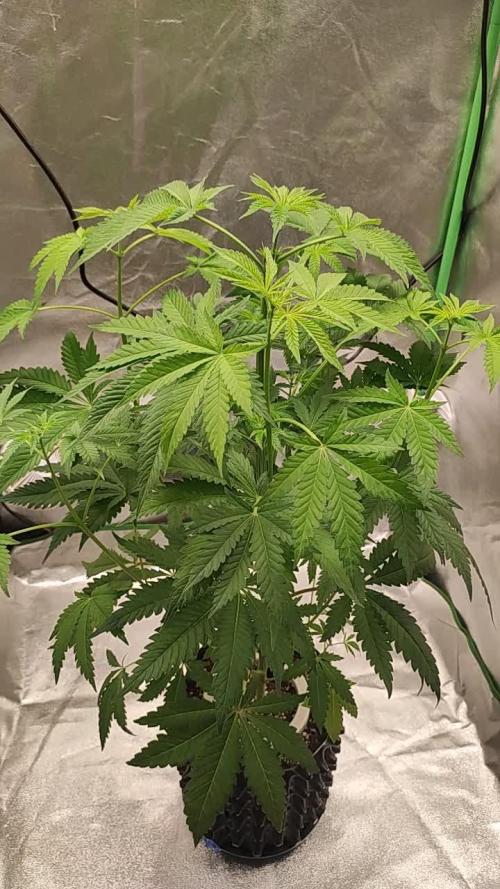The Grow Awards 2026 🏆 
































Likes
Comments
Share


@Mimi420
Follow
Hi growers!
The tent is looking gerrgus!They produce nice buds,and the smell from the tent is amazing!Can't wait to finish them....I had to remove some yelow leafs on the botom,becouse of bad airflow...But all in one they grow nice 🙂
Stay green!
Likes
8
Share


@Bncgrower
Follow
Second week of flora is complete, a few days ago she decided to show herself as a beautiful girl 💅🏻💅🏻💅🏻. Good development, very good structure and looking forward to the next few weeks.. 🏻💪🏻
Processing
Likes
16
Share


@PoshGrow
Follow
Welcome to Ultimate Auto Grow by PoshGrow!
🍀 Week #7 2020 October 12th. - 19th.
General Info:
When planted: 2020 September 1st.
Week: 7
Days: 42 - 49
Last Update Day: 2020 October 14th.
Plants:
4 x OG Kush Auto
3 x Amnesia Auto
5 xAlaskan Purple Auto
2 x Blueberry Auto
1 x Northern Lights Auto
Total: 15 girls.
NOTICE: Check week 1 for full equipment list!
UPDATE: I got 8 ltr. Or 2 gallon Spear&Jackson Pressure Sprayer to help me with watering.
Comment:
Did major clean up to remove all fan leaves blocking bud sites and all small branches with popcorn nugs, also for better light penetration and air flow.
OG Kush Auto all 3 girls showing really beautiful colors. Its going to be fun 😉
Peace! ✌️
Likes
4
Share


@Maincard
Follow
Sometimes watered only with water, three plants were already ready in the seventh week from germination. A week of watering with only water and I cut them down
Likes
14
Share


@GodZilla_Owner
Follow
Week 6 Update – Stretch Madness! 🌿
Things are going really well—maybe a little too well! 😅 The stretch has been insane, with the plants reaching 80cm in height and still growing. Honestly, they can stop anytime now!
I’m currently watering 3.5L every 36 hours to keep up with their needs.
BioBizz#1 – BT15
Everything looks good so far, but I checked the runoff and noticed a pH of 7.5. Not exactly ideal, considering my feed water has a pH of 6.7 without adjustments. Something to keep an eye on.
AN#4 – BT15
I’ve reached 100% of the feeding schedule with an EC of 2.5, and she’s handling it like a champ. Since bumping up the nutrients, she’s taken off and even overtaken BioBizz#1 in growth.
AN#3 – BT11
She’s been getting an EC of 2.1 for the past few days and seems to love it. At this rate, she’s going to outgrow my tent soon! 🙂
Likes
14
Share


@eldruida_lamota
Follow
Que pasa familia, vamos con la tercera semana de floración de estas Gorilla Zkittlez Auto de FastBuds.
La tierra que utilizamos que está en la publicación anterior es top crop all mix, aparte alimentamos nuestras plantas con Agrobeta.
Por supuesto el ph se mide en cada riego y se mantiene en 6.2, regando cada 48/72 horas e intentando mantener la humedad un poco alta al principio.
Se ven bien sanas tienen buen color y tamaño bueno, seguirán creciendo estas semanas espero.
Mars hydro:
Code discount: EL420
https://www.mars-hydro.com/
Agrobeta:
https://www.agrobeta.com/agrobetatiendaonline/36-abonos-canamo
Hasta aquí todo, Buenos humos 💨💨
Likes
38
Share


@DudeGrowsWeed
Follow
Baox got a transplant this week. Gave them just a little Recharge this week, I'll be increasing the dosage next week. So far they are both looking like happy and healthy little girls. 👍
Likes
9
Share


@bigolebuds
Follow
Week 9: Still coasting, but on the last day of this week the plants showed some major signs of being both thirsty and wanting some more nutrients. Not only were some leaves dried and shriveled, but others were limp and some new leaves started showing slight loss of green.
I'm attributing this to our delay in watering the plants this week and it being time for another round of 444. This will be their last full Veg fertilizing, before we flip. In 3/4 weeks we will feed half strength 444, half strength 284, another round of bloom boost, some recharge for the soil and we will hope for the biggest, densest, dankest mugs possible! Idk how I forgot to mention but at this point our babies are mothers! We let some of the branches get a little longer than we should before snipping and voila.. an opportunity for a new plant and maintained genetics.
A little behind on the scrog net, getting 2 plants out this tent, and feeding extra silica.. but I think our babies are gonna push through.
Likes
14
Share


@grower1212
Follow
Ayer hice el primer transplante a un solo cup de litro.
Encontré un gusano, debe ser del humos que le pongo al sustrato que reciclo, lo bueno que ahora puedo decir literalmente suelo vivo.
Les puse de top dress harina de neem como preventivo de plagas, insect frass y harina de malta para los microorganisms.
Likes
22
Share


@DunDerma
Follow
Growing very beautifuly and as intented. I changed the nutrition line to a brand where you feed it Once a week, and rest of the time use Phd Water.
Im also adding a secret bloom booster! (Hint: It makes the water purple)
More pictures from Week 12 are incoming.
I have been busy harvesting my first plant ever(Cream Caramel in my diary)
To avoid Caterpillar(Larvae) damage, I remove any fan leaves that has Damage, a larvae or larvae poop/eggs on it(black dots). Fortunally this plant has been much better than my previous one, I used Neem Oil treatment and it seems to work better, also I have fresh Peppermint, Lavender among other plants now in the garden that helps against different kinds of outdoor damage.
As a precaution I am massively defoliating the plant, and on my other photoperiod plant, as an experiment I decided to remove big fan leaves of some of main bud sites, the ones I removed fan leaves on, had denser and bigger buds when harvesting. I also tried doing it 50/50 experiment on the plant last week of bloom, and even there I could see a difference in harvest weight. So I might continue with this, depending on how future harvests go.
✌️🏽💚
Likes
44
Share


@Mr_Pgrow
Follow
Another wonderful auto to run and what a terp monster she turned out to be. Every square inch of her was covered in trichomes.
Her yield is impressive, Weighting in a 73g of flower and 23.9g of trim.
Overall very pleased, some of the best stash I have grow.... so far !!!!
Peace ✌️
Mr.PersonalGrow
Follow me here
https://www.theweedtube.com/user/Mr.PersonalGrow
Likes
11
Share


@21GRAMS
Follow
We started the flushing process by giving the girl plain water from the water trim without nutriens. New Ventilator to keep the hot ladies cool. We down 3 degree. Thang's getting juicy af. WE LIT <3
Likes
112
Share


@Tropicannibis_Todd
Follow
Alright Then
REMINDER I DO 2 UPDATES PER WEEK 👉WEEKLYROUNDUP👈👉MIDWEEKLY UPDATE👈
We just hit week 4 and all is well , have to admit she been a little bit of the runt of the litter ,still she keeps on pushing forward 😃 .......
So this little sprout is tuff one and has begun to start with pre-flowers👍 Still very little vertical growth , but I'm working on it 😏
Very little water given ,so far and rain water to be used entire growth
Her little sister is about 12 days behind and is playing catchup and she's doing great 👌
Lights being readjusted and chart updated .........👍
I GOT MULTIPLE DIARIES ON THE GO 😱 please check them out 😎
👉I WISH GD HAD DISCORD SERVER SO GROWMIES COULD HAVE A PLACE TO HELP AND TALK THINGS RELATED TO GROWING IN REAL TIME .....👈
👉SO I CREATED ONE ALL YOU NEED IS TO JOIN THE GROWDIARIES DISCORD SERVER !!!!!!!!!!!👈
LINK IS 👉
https://discord.gg/zQmTHkbejs
AND SEE HOW IT PLAYS OUT !!!!!!!
Likes
11
Share


@Loud_Jazz_de_Cavolo
Follow
Their first Neem oil leaf drench massage. Their first fertigation or watering.
For the Og kush the third week Biobizz nutrient dose was followed. The only addition to the third week All Mix dosology was the inclusion of Alg a mic. At the above rate + Great white + bactrex. The above list of nutrients correspond to the OG KUSH Allmix schedule and doses.
Fot the amnesia haze the watering had only Bactrex, White sark and Pro symbiotic at the doses listed above. No pH was adjusted nor measured and no EC either.
*03/29 UPDATE*
Since no option given for "breaking down" each strain individually ragarding the Nutrients section I ll update the irrigation/fertigation/nutrient regimen for each week in this section. Each time something changes on the Nutrients section it ll always be the last used doses of nutrients only for the OG Kush strain. For the Amnesia only CalMag treated water will be given in alternate irrigations along with a twice a week bacteria introduction to the system. So, today
both plants got 1.8 lts of RODI CalMag treated water to .340EC with a controlled pH of 6.3. The Amnesia had a significantly higher runoff which I didn't anticipate nor understand but I'll find out why for sure.
Some light LST directional guiding was given to the plants for forming purposes and future canopy levelling.
In the Grow Hut since day one the plants are continuously enjoying the company of Pandit Hariprasad Chaurasia s music. They love it!
*03/30 UPDATE*
The best possible outcome regarding live phytoprotection by beneficial insects for pest control.
As of yesterday I have two unidentified tiny sliders, possibly common garden ones and as of today a Coccinellidae sp. larvae running around the canopy (check the video) Hope for many more of them sweet protectors. Neem oil along with DE has successfully helped in deterring some Gnat "congregation".
*03/31 UPDATE*
Plants are growing strong and vigorous. Some LST done and their new canopy hairdo can be seen in the pics.
Likes
17
Share


@Northerngrowers
Follow
A pesar de los contratiempos en las primeras fases de crecimiento las plantas han conseguido exprimir todo su potencial y hemos obtenido unas flores de primera calidad repletas de tricomas y un alto porcentaje en thc.
Flores con tonos morados y negros hacen que su aspecto sea mas impresionante todavía.
Un sabor muy sutil, diferente pero muy agradable digno de paladares expertos. Efecto relajante, placentero, sensación de felicidad, apto para cualquier hora del día.
Una gran genética.
Totalmente recomendable.
Likes
64
Share

taking it easy on the nutes.... once the roots Hit the water ....she's going to take off. I got a little too ambitious with the nutes.... and got some nute Burn... but she'll be okay... I flushed her ......very very light on the nutes now.... the new growth is green so she'll be alright.... (((patience young grasshopper))))
Likes
43
Share


@biggreens420
Follow
Got some better shots without light and a little video my cam is a bit shit got a video of trichs also in there girls seem to be flushing well started flushing the quick one later than the others as wasn't as developed. Took the 2 tester buds of very bottom under the plants on the first day of flush to try estimate how long to flush for........last pic and vid before harvest next uploads will be harvest hopefully



























